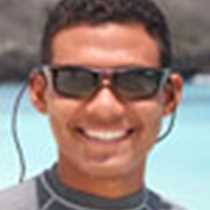After the first day that our guests enjoyed in the Galapagos, the National Geographic Islander moved south towards Española Island.
Española is by far the last standing survivor from the last generation of islands created four million years ago. It was formed by a series of volcanic eruptions and uplifts, but was later eroded by waves, wind, and time. The location makes it a perfect paradise for sea lions, and a fantastic nesting area for sea birds.
Eruptions millions of years ago took place on the northeastern side of the island, bringing different compositions of lava. Those eruptions that reached the ocean started to heat up the water and therefore killed many species of animals and plants. Several of the species affected by this phenomenon are shells and corals. Wave action took place as the saltiness of the ocean broke all of these organisms until a beach resulted from such a process. Sandy beaches are the most comfortable places for Galapagos sea lions to relax and rest after spending several days out in the middle of the ocean looking for food to bring back to their pups. The name of this place is Gardner Bay, and during the morning our guests practiced snorkeling activities in these waters, and enjoyed some time at the beach walking along the sea lion’s colony.
Ecuador has very varied cuisine from region to region and the galley team gave a demonstration of it during lunch to our guests with salads, desserts, and ceviche.
Later, on the other corner of Española, time polished the rocks making them smooth enough for the animals to form a nesting site. Marine iguanas have found the areas with algae-covered rocks as their feeding ground, but also not far from there sandy places are used as nesting sites for them. Two different species of boobies arrived at this part of the island many thousands of years ago. Blue-footed boobies and Nazca boobies now nest here depending on the season. Many other species of reptiles and birds live up there including a very special one. Coming every April and leaving in December, with a seven-foot wingspan the waved albatross is one the most iconic animals in the archipelago. Their population reaches several thousands of individuals continuing with their complex monogamous relationships every year.
Punta Suarez was the last place we visited during our time here, with a pleasant long hike inside the island.
The trip continues and more experiences will soon come!









